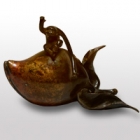Japanese Gallery (Honkan) Room 14
January 14, 2015 (Wed) - April 5, 2015 (Sun)
Liquid ink for brush painting and calligraphy was prepared by grinding a hardened stick of ink against an inkstone containing water. Utensils with spouts for pouring water into these inkstones are known as water droppers. There are small ones as well as larger ones roughly the size of teapots, although Spoutless water containers with spoons for transferring the water to inkstones were also used. Together with brushes and brush racks, as well as inkstones and the small standing screens used to decorate them, these utensils were prized in countries with traditions of brush and ink. Moreover, they were created with various materials and featured elaborate shapes and designs. The most common material was ceramic, although metals and semi-precious stones were also used. Early examples of Chinese water droppers are from the Southern and Northern Dynasties period (5th-6th century), while the earliest known example in Japan is a Nara period (8th century) gilt bronze piece, now part of the Horyuji Treasures collection at this museum. Metal water droppers continued to be made through the ages and from the Edo period (1603-1868), intricate designs making the most of highly-developed metalwork techniques and based on animals, plants, as well as stories surrounding historical and legendary figures were created.
The Sen’en Collection of 442 metal water droppers - donated in its entirety to the museum in 2013 - was accumulated by Watanabe Toyotaro (Sen’en) and his son, Masayuki. Pieces from the Edo period feature designs of various genres and include many rare examples of cloisonné. This is indeed a superb collection in terms of both number and quality. For this exhibition, pieces from each genre have been selected for a total of 138, allowing visitors to explore the diversity and rich artistic expression found in metal water droppers.

